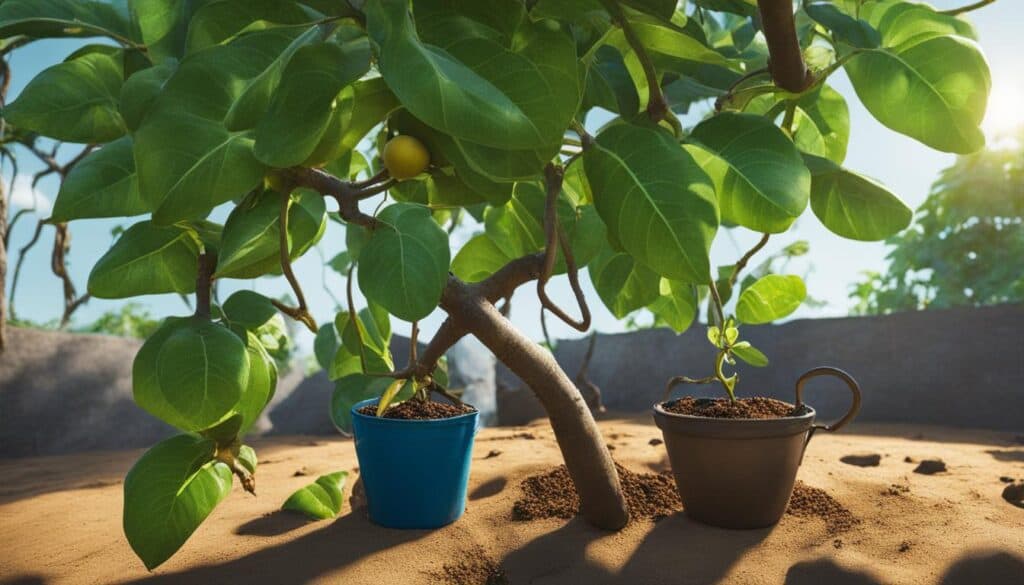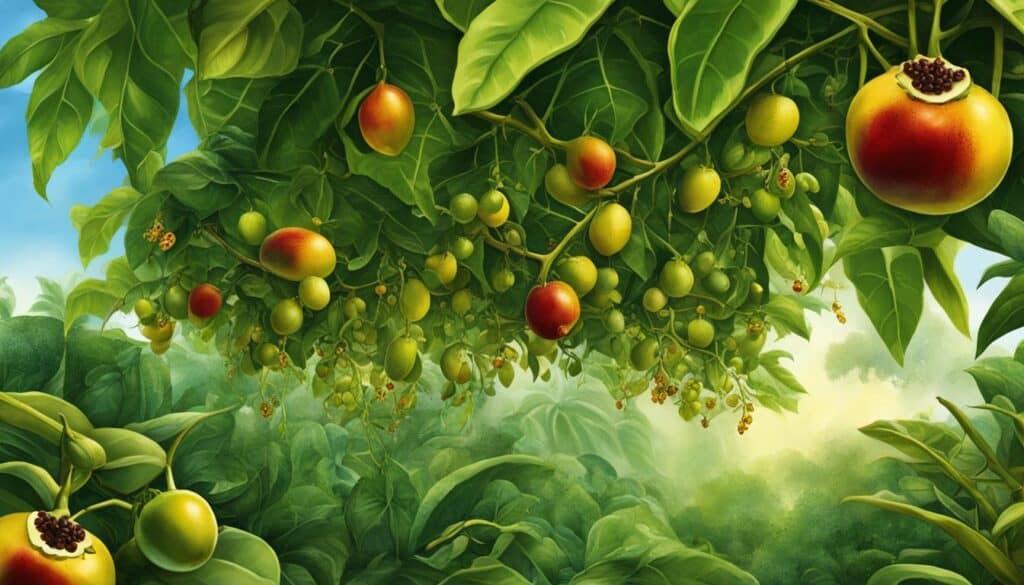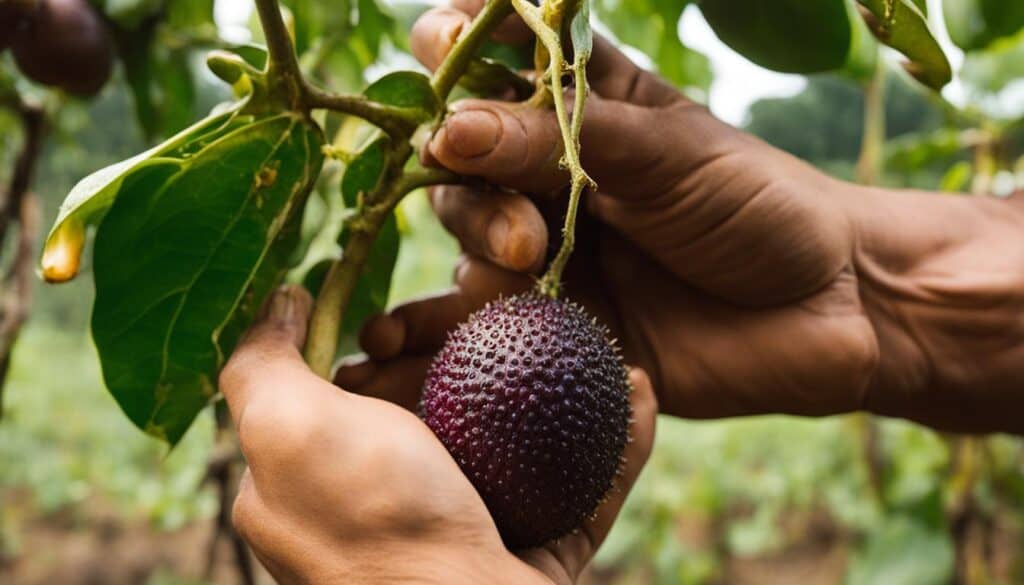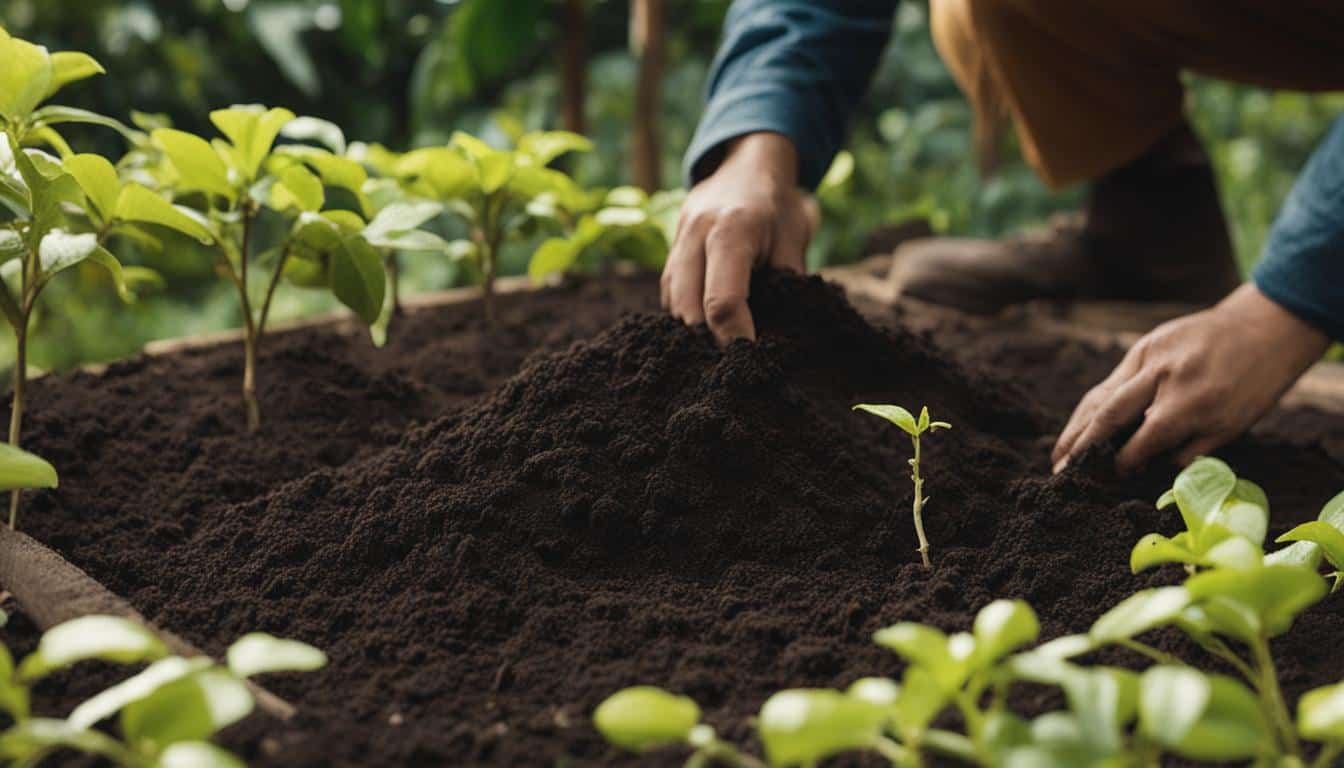Growing passion fruit can be a delightful experience, but it’s essential to know the ideal planting time to ensure successful cultivation. Passion fruit is a vigorous vine that thrives in the warmest parts of New Zealand. With its attractive flowers and delicious fruit, it’s no wonder that passion fruit is a favorite among gardeners.
So, when is the best time to plant passion fruit? The ideal planting time for passion fruit is between mid-spring and mid-summer. This timeframe allows the vines to establish themselves before the colder seasons set in, ensuring healthy growth and fruit production. If you’re planning to grow passion fruit in the current year, now is the perfect time to get started!
When planting passion fruit, it’s important to select a spot in your garden that receives full sun. Passion fruit vines thrive in well-drained soil with a pH of 6.5-7.5, so make sure your soil meets these requirements. Good drainage is crucial to prevent waterlogging, which can lead to root rot and stunted growth.
The passion fruit vine can reach impressive heights of up to six meters in just one year. To encourage healthy growth and fruiting, it’s recommended to provide support in the form of a trellis, wall, or deck. The vines should also be spaced at least two meters apart to allow for proper air circulation.
Remember, patience is key when growing passion fruit. It takes approximately 18 months for the vines to start fruiting after planting. But with the right planting time and proper care, you’ll soon be rewarded with an abundance of delicious passion fruit.
Key Takeaways:
- The ideal planting time for passion fruit is between mid-spring and mid-summer.
- Passion fruit vines should be planted in full sun and well-drained soil with a pH of 6.5-7.5.
- Provide support, such as a trellis or wall, for the vines to climb.
- Space the passion fruit vines at least two meters apart to allow for proper air circulation.
- Be patient, as it takes about 18 months for the vines to start fruiting after planting.
Passion Fruit Varieties for Home Gardeners
Home gardeners have a wide selection of passion fruit varieties to choose from, each with its own unique characteristics and flavors. Whether you prefer vibrant flowers, sweet aromatic fruits, or a combination of both, there is a passion fruit variety that will suit your taste and garden preferences.
Here are some of the popular passion fruit types that are well-suited for home gardens:
| Variety | Flower Color | Fruit Color | Taste |
|---|---|---|---|
| Black Beauty | White and purple | Dark purple | Juicy yellow-orange pulp |
| Giant Granadilla | Showy | Oval | Fruity aroma |
| Sweet Granadilla | White and purple | Round orange | Delightful sweetness |
| Red Banana | Red | Oblong yellow | Sweet, juicy pulp |
While these passion fruit varieties are excellent choices for home gardens, it is essential to note that banana passionfruit is considered a noxious weed and should be avoided in home cultivation.
With these top passion fruit varieties, you will enjoy an abundance of delicious fruits and beautiful flowers in your own backyard!
Planting Passion Fruit: Tips and Techniques
When it comes to planting passion fruit, choosing the right location and following the proper techniques can greatly contribute to the success of your passion fruit vines. Here are some essential tips and step-by-step instructions to help you get started:
- Choose a sheltered spot in the garden: Find a location next to a wall, trellis, or deck that provides protection from strong winds. This will prevent the vines from being damaged or uprooted during harsh weather conditions.
- Spacing the vines: Passion fruit vines should be spaced at least two meters apart. This allows each plant to have sufficient room for growth and helps prevent overcrowding.
- Preparing the hole: For planting in the garden, dig a hole that is twice the depth and width of the root ball. This ensures that the roots have enough space to spread out and establish themselves properly.
- Loosening the root ball: Before placing the passion fruit plant in the hole, gently loosen the root ball. This encourages the roots to grow outwards and helps them establish better contact with the surrounding soil.
- Using Tui Citrus & Fruit Mix: Partly fill the planting hole or pot with Tui Citrus & Fruit Mix. This specialized mix provides the necessary nutrients and drainage for healthy passion fruit growth.
- Planting in the garden: Carefully place the loosened root ball into the hole and backfill it with soil mixed with Tui Citrus & Fruit Mix. Gently firm the soil around the plant to ensure it is secure.
- Planting in pots or containers: For container planting, partly fill the pot with Tui Citrus & Fruit Mix. Loosen the root ball of the passion fruit plant and position it in the center of the pot. Fill the remaining space with the mix, leaving about 2-3cm of space from the top of the container.
- Well-drained soil with organic matter: Passion fruit vines prefer well-drained soil that is rich in organic matter. Ensure the soil provides good drainage while retaining enough moisture for plant growth.
By following these planting tips and techniques, you can create an ideal environment for your passion fruit vines to thrive and produce abundant fruits. Keep in mind that passion fruit plants require proper care and maintenance throughout their growth cycle, including regular feeding, watering, and pruning. Refer to the upcoming sections for more detailed information on nourishing passion fruit plants, growing conditions and climate requirements, as well as pruning and maintenance techniques.
Nourishing Passion Fruit Plants for Optimal Growth
Passion fruit plants require proper care and nourishment to ensure optimal growth and a bountiful harvest. By providing the right nutrients, water, and pruning, you can support the health and vigor of your passion fruit vines.
Feeding Passion Fruit Plants
Just like any other plant, passion fruit plants need regular feeding to thrive. During the spring and summer months, when the vines are actively growing, it is essential to provide them with a balanced fertilizer to support healthy foliage and fruit production. Two recommended options are:
- Tui Citrus Food
- Tui General Fertilizer
These fertilizers are specifically formulated to meet the nutritional needs of citrus and fruiting plants, including passion fruit. Follow the instructions on the packaging for proper application rates and frequency.
Watering Passion Fruit Plants
Proper watering is crucial for the success of passion fruit plants. While they do require regular watering, it is important to avoid overwatering, as this can lead to root rot and other issues. Water the plants deeply, ensuring the soil is moist but not waterlogged.
During the fruiting stage, which usually occurs in late summer to early autumn, it is especially important to monitor the moisture level and provide adequate water to support the development and ripening of the fruit.
Pruning Passion Fruit Vines
Pruning is an essential part of passion fruit plant care. It helps stimulate new growth, maintain plant vigor, and improve air circulation, which can reduce the risk of disease. Pruning should be done in autumn, after the fruiting season, to avoid disturbing the current year’s crop.
When pruning passion fruit vines, focus on removing weak, dead, and criss-crossing vines. This allows sunlight to penetrate the plant, promotes better air circulation, and reduces the risk of pests and diseases. Pruning also helps shape the plant and control its growth.
Pest and Disease Control for Passion Fruit Plants
Like any other plant, passion fruit is susceptible to pests and diseases. To protect your plants, it is recommended to take preventive measures and implement proper pest and disease control strategies.
“A clean-up spray with a copper-based fungicide and horticultural spraying oil is recommended in autumn and winter to prevent pest and disease problems.”
This clean-up spray helps eliminate any fungal spores or pests hiding in the dormant plant parts and prevents them from causing problems in the upcoming growing season. Copper-based fungicides can help control common fungal diseases such as powdery mildew, while horticultural spraying oil can smother overwintering pests and their eggs.
Regularly monitor your passion fruit plants for signs of pest activity or disease symptoms. Early intervention is key to preventing serious infestations or the spread of diseases.

| Plant Care Task | Timing |
|---|---|
| Feeding with balanced fertilizer | Spring and summer |
| Watering | Regularly, ensuring soil moisture but avoiding overwatering |
| Pruning | Autumn, after fruiting season |
| Pest and disease control spray | Autumn and winter |
Growing Conditions and Climate Requirements for Passion Fruit
Passion fruit is a tropical vine that thrives in specific growing conditions and climate. Understanding the ideal requirements for passion fruit cultivation is crucial for successful and productive results.
Ideal Climate for Passion Fruit
Passion fruit plants prefer a frost-free climate and flourish in regions with warm temperatures. The ideal temperature range for passion fruit growth is between 68 and 82 degrees Fahrenheit (20-28 degrees Celsius). This heat-loving plant requires a warm climate to thrive and produce abundant fruit.
Temperature Requirements for Passion Fruit
“Passion fruit plants thrive in warm temperatures, requiring a frost-free environment and a tropical or subtropical climate.”
Passion fruit vines excel in full sun exposure, although they can tolerate partial shade, especially in areas with intense heat. The abundant sunlight enhances the plant’s growth, flowering, and fruit production.
Soil Requirements for Passion Fruit
Passion fruit plants are versatile and can adapt to various soil types. However, they prefer well-drained sandy loams with a pH range of 6.5-7.5. These soil conditions promote healthy root development, nutrient absorption, and overall plant vigor.
Passion fruit roots are shallow, emphasizing the need for good drainage to prevent waterlogging, which can lead to root rot. Prior to planting, incorporating organic matter like composted manures and adding a little lime to the soil helps improve its structure and nutrient content.
Growing Conditions for Passion Fruit
The optimal growing conditions for passion fruit encompass a frost-free climate, warm temperatures, abundant sunlight, and well-drained soil. By ensuring these conditions are met, passionate gardeners can foster healthy and productive passion fruit vines.
| Growing Conditions | Climate Preference | Temperature Range | Soil Type |
|---|---|---|---|
| Preferred Conditions | Tropical or subtropical | 68-82°F (20-28°C) | Well-drained sandy loam |
| Additional Considerations | Full sun exposure | Can tolerate some shade | pH 6.5-7.5 |
Pruning and Maintenance of Passion Fruit Vines
Pruning is an essential aspect of caring for passion fruit vines. It helps control their growth, maintain their health, and ensure a bountiful harvest. To keep your passion fruit vines thriving, follow these pruning and maintenance tips:
1. Timing is Everything
The best time to prune your passion fruit vines is in early spring, after the risk of frost has passed. This allows the plants to recover and start producing new growth before the growing season.
2. Cut Back for New Growth
When pruning, aim to cut back the vines by approximately one third. This stimulates new growth and encourages the plant to produce more flowers and fruit. Use clean, sharp pruning shears to make clean cuts, and always cut just above a bud or node.
3. Remove Weak and Dead Vines
While pruning, carefully inspect the vines and remove any weak, dead, or diseased growth. These vines not only hinder the plant’s overall health but can also reduce air circulation, increasing the risk of pest and disease problems.
4. Enhance Air Circulation
To prevent disease and maintain optimal plant health, ensure proper air circulation within the vine canopy. Remove criss-crossing and overcrowded vines that create a dense growth pattern. This will promote better airflow and reduce the likelihood of fungus or mold developing.
5. Regular Leaf Removal
Regularly remove fallen leaves and brown leaves from the vine. These can harbor pests and diseases, impacting the overall health of the plant. Keeping the vine clean and free from debris reduces the risk of infestation or the spread of diseases.
| Pruning Benefits | Maintenance Tips |
|---|---|
| Stimulates new growth | Regularly remove fallen and brown leaves |
| Improves air circulation | Inspect for weak, dead, and diseased growth |
| Reduces the risk of disease | Enhance overall air circulation |
| Enhances fruit production | Prune in early spring |
Regular pruning and maintenance of your passion fruit vines are essential to ensure healthy growth and abundant fruit production. By following these tips, you’ll be well on your way to a thriving and fruitful passion fruit garden.
Common Problems and Pest Control for Passion Fruit Plants
Passion fruit plants, like any other plants, can encounter various problems and pests that can affect their growth and overall health. By understanding these issues and implementing appropriate pest control measures, you can ensure the well-being of your passion fruit plants and maximize your harvest.
Root Rot: A Common Issue
One of the most common problems faced by passion fruit plants is root rot, which is caused by a fungus called Phytophthora. This disease occurs mainly in poorly drained soil, where excess water stagnates around the roots. The fungus thrives in such conditions and attacks the plant’s root system, leading to rotting roots and eventual plant decline.
To prevent root rot, ensure that your passion fruit plants are grown in well-drained soil. This can be achieved by adding organic matter, such as compost or well-rotted manure, to improve soil structure and drainage. Additionally, avoid overwatering and ensure that water does not accumulate around the root zone.
Pest Control: Dealing with Aphids and Snails
Passion fruit plants can also fall victim to common pests, such as aphids and snails, which can cause significant damage if left unchecked.
Aphids are tiny insects that feed on plant sap, leading to distorted and mottled leaves. They can also transmit viruses that can further weaken the plant. If you notice aphids on your passion fruit plants, it’s important to take prompt action. Remove and replace severely affected plants to prevent the spread of viruses.
Snails are another common pest that can strip the leaves of passion fruit plants, hindering their growth and fruit production. To control snails, you can employ various methods such as handpicking them off the plants, creating physical barriers, or using organic slug and snail baits.
Diseases: Fusarium Wilt, Nematodes, and Crown Rot
In addition to root rot, passion fruit plants are susceptible to other diseases such as fusarium wilt, nematodes, and crown rot.
Fusarium wilt is a fungal disease that affects the vascular system of the plant, causing wilting, yellowing of leaves, and eventual plant death. To prevent fusarium wilt, it is recommended to plant passion fruit on mounds or ridges to improve drainage and aeration. Additionally, using appropriate fungicides can help protect the plants from this disease.
Nematodes are microscopic worms that live in the soil and feed on plant roots, causing stunted growth and poor fruiting. The best way to control nematodes is through crop rotation, as planting passion fruit in the same spot repeatedly can increase their population. Additionally, using nematode-resistant passion fruit varieties can minimize the risk of nematode damage.
Crown rot is a fungal disease that affects the base of the plant, leading to decay and death of the crown tissue. To prevent crown rot, it is important to plant passion fruit in well-drained soil and avoid overwatering. Regularly inspecting the plants for any signs of disease and promptly removing and destroying affected plant parts can help manage crown rot.
To summarize, here are the common problems and pest control measures for passion fruit plants:
| Problem | Pest Control Measures |
|---|---|
| Root Rot | – Ensure well-drained soil – Avoid overwatering – Improve soil structure with organic matter |
| Aphids | – Remove and replace severely affected plants – Apply organic insecticides |
| Snails | – Handpick snails – Use physical barriers – Apply organic slug and snail baits |
| Fusarium Wilt | – Plant on mounds or ridges – Use appropriate fungicides |
| Nematodes | – Practice crop rotation – Use nematode-resistant varieties |
| Crown Rot | – Plant in well-drained soil – Avoid overwatering – Remove and destroy affected plant parts |

This image showcases healthy passion fruit plants, free from common problems and pests.
Benefits of Passion Fruit for Health and Well-being
Passion fruit is not only delicious but also offers a plethora of health benefits. Packed with essential nutrients, this exotic fruit can contribute to your overall well-being in various ways.
Nutritional Value of Passion Fruit
Passion fruit is a nutrient powerhouse, providing you with a range of essential vitamins and minerals. Here are some key nutrients found in passion fruit:
| Nutrient | Amount per 100g |
|---|---|
| Vitamin A | 1275 IU |
| Vitamin C | 30 mg |
| Potassium | 348 mg |
| Calcium | 12 mg |
| Iron | 1.6 mg |
These nutrients contribute to the health and functioning of various systems in your body, including immune support, bone health, and iron absorption.
Medicinal Uses of Passion Fruit
The leaves of the passion fruit plant have long been used in traditional medicine for their medicinal properties. They are believed to have sedative or calming effects and are often used to promote relaxation and relieve anxiety. Passion fruit leaves have also been used as a natural remedy for sleep disorders and to support a restful night’s sleep.
I have always turned to passion fruit tea when I need to unwind and relax. Its calming properties help me to de-stress after a long day. – Sofia, Passion Fruit Enthusiast
The fruit itself is also known for its potential medicinal uses. It is believed to have heart-healthy properties, supporting cardiovascular health and reducing the risk of heart disease. Additionally, passion fruit has been used in traditional remedies for urinary infections, digestive issues, and respiratory problems.
Calming Properties of Passion Fruit
Passion fruit is well-known for its calming properties, making it a popular ingredient in natural remedies for anxiety and insomnia. Its soothing effect on the nervous system can help promote a sense of relaxation and reduce feelings of stress. Incorporating passion fruit into your diet or enjoying a cup of passion fruit tea can be a great way to experience its calming benefits.

In summary, passion fruit is not only a delightful tropical fruit but also a valuable source of essential nutrients. Its leaves and fruit have been used in traditional medicine for their sedative and heart-healthy properties. Incorporating passion fruit into your diet can be a tasty way to support your overall health and well-being.
Tips and Tricks for Growing Passion Fruit Successfully
Passion fruit cultivation requires attention to detail and a few tricks up your sleeve to ensure optimal growth and a bountiful harvest. Here are some tips to help you successfully grow passion fruit:
Provide Ample Space for Growth and Climbing
Passion fruit vines are vigorous climbers, so it’s essential to provide enough space for them to grow and climb. Set up a trellis or sturdy support system to guide the vines and prevent them from sprawling across the ground.
Choose the Right Location
Passion fruit thrives in a sunny and frost-free spot, so choose a location in your garden that receives full sun throughout the day. The vines also require well-drained soil to prevent waterlogging and root rot.
Regular Feeding and Watering
To ensure robust growth and fruit production, feed your passion fruit plants regularly with a balanced fertilizer. Water them consistently, especially during dry periods and when the fruits are approaching maturity. Avoid overwatering, as this can lead to root rot.
Pruning and Maintenance
Proper pruning is crucial for maintaining the health and productivity of passion fruit vines. Prune in early spring to stimulate new growth and remove any weak or dead vines. Regularly remove fallen leaves to prevent pest and disease problems.
Prevention and Control of Common Problems
Passion fruit plants are susceptible to root rot, pests, and diseases. Take preventive measures by ensuring good drainage, practicing proper hygiene, and regularly inspecting your plants for any signs of trouble. Use appropriate treatments or organic remedies to control pests and diseases.
| Common Problems | Pest Control | Disease Control |
|---|---|---|
| Root rot | Monitor soil moisture levels and improve drainage. Avoid overwatering. | Apply a copper-based fungicide to prevent fungal infections. |
| Aphids | Use insecticidal soap or neem oil to control aphid populations. | N/A |
| Snails | Set up beer traps or handpick snails to control their populations. | N/A |
By following these tips and tricks, you’ll set the stage for successful passion fruit cultivation. From providing the right growing conditions to maintaining good plant health, your efforts will be rewarded with an abundance of delicious passion fruit.

Recipe: Passion Fruit and Coconut Tart
Looking for a delicious recipe to showcase your passion fruit harvest? Try Janine’s tasty Passion Fruit and Coconut Tart. This dessert combines the tangy, musky flavor of passion fruit with the creamy texture of coconut for a truly delightful treat. Whether you’re hosting a summer party or just want to indulge in a sweet and tropical dessert, this recipe is sure to please.
Ingredients:
- 1 cup passion fruit pulp
- 1 cup shredded coconut
- 1/2 cup sugar
- 1/4 cup cornstarch
- 1/4 teaspoon salt
- 2 cups milk
- 1 teaspoon vanilla extract
- 1 pre-made pie crust
Instructions:
- In a saucepan, combine the passion fruit pulp, shredded coconut, sugar, cornstarch, and salt.
- Gradually add the milk, stirring constantly, and cook over medium heat until the mixture thickens and comes to a boil.
- Remove from heat and stir in the vanilla extract.
- Pour the mixture into the pre-made pie crust and let it cool at room temperature.
- Once cooled, refrigerate the tart for at least 2 hours to set.
- Serve chilled and garnish with additional passion fruit pulp and shredded coconut if desired.
This Passion Fruit and Coconut Tart is the perfect combination of flavors and textures. The tanginess of the passion fruit pairs beautifully with the sweetness of the coconut, creating a tropical dessert that is both refreshing and indulgent. Serve it as a delightful ending to a special meal or enjoy it as a treat on its own. Either way, this tart is sure to impress!
Conclusion
Growing passion fruit in your garden can be a truly rewarding experience. With the right knowledge and techniques, you can enjoy the beauty of its flowers and the deliciousness of its fruit. To summarize the key tips for successful passion fruit cultivation:
Firstly, make sure to plant your passion fruit vines during the ideal planting time, which is between mid-spring and mid-summer. This will give them enough time to establish and start fruiting.
Secondly, provide the right growing conditions for your passion fruit plants. They thrive in full sun and well-drained soil with a pH of 6.5-7.5. Regular feeding, watering, pruning, and maintenance are also important for their optimal growth.
Lastly, don’t be afraid to try different passion fruit varieties and explore various recipes. The versatility of this exotic fruit allows you to create delicious desserts, drinks, and more.
So go ahead, start your passion fruit journey and experience the joy of growing your own tropical fruits. Happy passion fruit growing!
FAQ
When is the ideal time to plant passion fruit?
The ideal planting time for passion fruit is between mid-spring and mid-summer.
What are the top varieties of passion fruit for home gardeners?
The top varieties of passion fruit include Black Beauty, Giant Granadilla, Sweet Granadilla, and Red Banana.
What are some tips for planting passion fruit?
When planting passion fruit, choose a sheltered spot, space the vines at least two meters apart, and provide well-drained, rich soil.
How should I care for passion fruit plants?
Passion fruit plants should be regularly fed with a balanced fertilizer, watered adequately, and pruned to stimulate new growth.
What are the growing conditions and climate requirements for passion fruit?
Passion fruit thrives in a frost-free climate with a temperature range of 68 to 82 degrees Fahrenheit and prefers well-drained sandy loam soil.
How should I prune and maintain passion fruit vines?
Prune passion fruit vines in early spring, cutting back approximately one third of the vines, and remove weak, dead, and criss-crossing vines to improve air circulation.
How can I control common problems and pests of passion fruit plants?
Regular watering, proper drainage, and appropriate application of fungicides can help prevent root rot, aphids, snails, and diseases such as fusarium wilt and crown rot.
What are the health benefits of passion fruit?
Passion fruit is packed with nutrients and is high in vitamins A and C, potassium, calcium, and iron. It has been used in traditional medicine for its sedative and calming properties.
What are some tips and tricks for growing passion fruit successfully?
Provide ample space for the vines to grow, choose a sunny and frost-free spot with well-drained soil, and experiment with different passion fruit varieties and recipes.
Do you have a recipe featuring passion fruit?
Yes, try Janine’s tasty Passion Fruit and Coconut Tart for a delightful dessert combining the tangy flavor of passion fruit with the creamy texture of coconut.
Any final thoughts on passion fruit cultivation?
Passion fruit is a rewarding plant to grow, providing beautiful flowers and delicious fruit. Following proper planting, care, and maintenance techniques will yield a bountiful harvest.





Leave a Reply